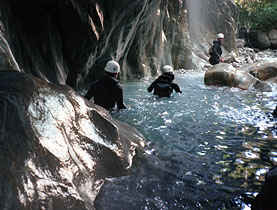
Adventure sports safer ten years after tragedy

A decade after 21 people died while on a canyoning trip in Switzerland, experts say tougher safety measures have made adventure sports less dangerous.
But they warn that despite the subsequent introduction of a set of standards under the Safety in Adventures scheme, the element of risk – and the consequences – will always remain.
Earlier this month, two women died in a white water rafting accident near Wilderswil, in the Bernese Oberland. Along with five other passengers and one guide, they were thrown from their raft as it capsized in rapids.
Ten years earlier, 18 tourists and three guides drowned after being caught in a flash flood while canyoning in Saxetenbach, not far away. Managers from the now-defunct company in charge of the trip were later found guilty of negligent manslaughter.
The tragedy led to Switzerland stepping up regulations, with the Safety in Adventures measures brought in and backed by the cantons, the Federal Sport Office, the Swiss Outdoor Association and the Swiss Council for Accident Prevention.
To conform, outdoor sports companies must have well-trained staff, quality equipment and undergo a series of checks every year.
“In this sense, yes, the certification is a guarantee of quality that seems sufficient to us,” Magali Dubois, spokeswoman for the Swiss Council for Accident Prevention, told swissinfo.ch. “Nevertheless it does not prevent all risk, especially in activities that are intrinsically potentially dangerous.”
The firm in charge of the latest fatal trip bore the Safety in Adventures label.
The Swiss Outdoor Association says the weather and water conditions on the Lütschine River were not problematic on the day and that other excursions had also taken place.
“Maximum guarantee”
“I think in general if you want to do adventure sports like that you have to know that there is a risk,” Hans Allemann of the Swiss Outdoor Association said.
“But statistically we say the risk in adventure sports, rafting and canyoning, is more or less around the same as driving a car.”
He told swissinfo.ch that the label Safety in Adventures set a standard by which to judge the various companies running excursions in Switzerland.
“From the outside it is very hard to see how a company works. But with this label, that gives the maximum guarantee of a company working at a good level. But still there is always a risk, as we have seen last week with this accident.”
He notes that “in general” outdoor sports like canyoning and rafting are now safer than they were ten years ago.
“There have been big changes in recent years. For example there are Swiss-wide training courses and also exams for guides for canyoning and rafting. There are lots of checks of how companies work, how employees are trained, if insurance is correct.”
The heyday
The Swiss Council for Accident Prevention also attributes the relatively low number of deaths in recent years – just five canyoning fatalities between 2000 and May 2009 – to the higher standards.
In comparison, there are around 30 swimming related deaths in pools and lakes each year.
“The council therefore strongly recommends interested people choose a provider that holds the Safety in Adventures label,” said Dubois.
Katrin Blumberg, CEO of Swissraft Adventures, a firm based in Ilanz, says the biggest change for companies under the new standards is that all guides must be correctly certified, which means any new recruits from abroad also need to undergo Swiss training.
Blumberg says rafting had its heyday in the 1990s and bookings later dropped as people became concerned about safety. Now, business is picking up again, with more safety-conscious schools and businesses opting for easier trips, and the more adventurous routes popular among individuals.
“For a while it used to be ‘the’ adventure sport. Now it is just one of the adventure sports on offer,” she added.
Jessica Dacey, swissinfo.ch
The Safety in Adventures Foundation aims to improve safety among air and adventure services and awards the Safety in Adventures label.
The label consists of a blue letter ‘s’ with the Switzerland Tourism edelweiss insignia. Certified businesses must show evidence of their respect to nature and care for the protection of clients.
Companies are evaluated by an independent organisation which specialises in audits and calls on experts.
The label entails that firms have introduced their own safety objectives. It shows clients that a company has met high safety standards and sets a common standard by which tourism organisations, insurance suppliers and the authorities can judge companies.
Holders are seen to have exemplary standards, even in other domains such as the protection of nature.
Employees must be trained, experienced and possess appropriate personal aptitudes.
Equipment must guarantee the maximum safety to users.
All activities should be planned out, and action plans identified for emergency situations.
Self-testing and regular evaluation of the conditions for safety are required.
Third parties involved in any activity should meet the same requirements.
All checks and assessments must be recorded.

In compliance with the JTI standards
More: SWI swissinfo.ch certified by the Journalism Trust Initiative


























You can find an overview of ongoing debates with our journalists here . Please join us!
If you want to start a conversation about a topic raised in this article or want to report factual errors, email us at english@swissinfo.ch.